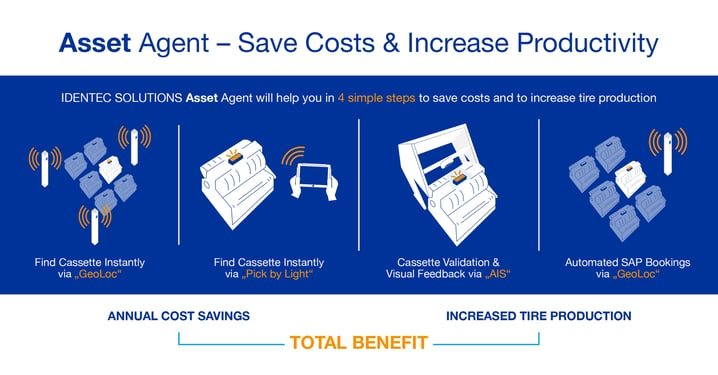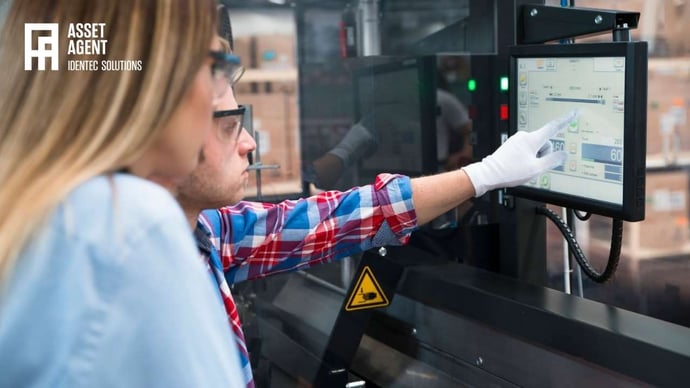IIoT: Answering the big digitalisation question in tyre manufacturing
| Written by Christian Aadal
Digitalisation is transforming the way companies do business, and the tyre manufacturing industry is no exception. From increased efficiency to better quality control and cost savings, there are many advantages of leveraging digitalisation in tyre manufacturing.
In this article, we’ll take a look at how digitalisation can be used to help tyre manufacturers achieve better results in terms of productivity and quality. We’ll delve into how a digital intra-factory supply chain increases efficiency and how digital production can help manufacturers reduce costs. Finally, we’ll explore the key benefits of digitalisation in tyre manufacturing through Asset Agent.

No video selected
Select a video type in the sidebar.
In order to reduce production costs in tyre manufacturing, any IIoT-based solution must help to increase machine utilization, reduce scrap of raw materials, eliminate production errors of the final product and increase labour productivity (What is RTLS?).
How Can Digitalisation Help Tyre Manufacturing?
Digitalisation has become increasingly important in the tyre manufacturing industry in recent years, as it can help to increase efficiency, reduce costs and improve the quality of products. Digitalisation can be used in a variety of ways to improve the quality and quantity of tyres that can be produced. Learn more about the production process of a green tire.
The global smart tyre market, driven by digital technologies, is projected to experience significant growth in the coming years. Major tyre manufacturers such as Michelin, Bridgestone, Continental, and Goodyear are heavily investing in digital transformation to enhance their production capabilities and competitiveness. The adoption of digitalization in tyre manufacturing has the potential to increase production efficiency by 20–30% while reducing defects by up to 50%, leading to improved product quality, cost savings, and greater operational efficiency. (1)
For instance, digitalisation can be used to automate processes in tyre production, allowing machines to undertake specific tasks that would otherwise be done by humans. This can help reduce production costs and increase production speeds, allowing more tyres to be produced in a shorter period. Digitalisation can also help reduce the amount of time spent on manual assembly and inspection and ensure that all tyres are of the highest quality.
Digitalisation can also be used to streamline the supply chain for tyre manufacturing. By collecting data on orders, suppliers and customers, digitalisation can help reduce the time and resources needed to track orders and deliveries. This can lead to reduced costs and improved customer satisfaction as orders are received faster and accurately tracked.
Finally, digitalisation can also be used to increase the level of innovation and efficiency of tyre manufacturing. By using digital tools such as analytics, predictive modelling, and machine learning, tyre manufacturers can gain insight into customer preferences and behaviour and forecast future trends. This knowledge can be applied to create more efficient workflows and processes, to create high-quality tyres that meet customer demands.
Increased Productivity
Digitalisation in tyre manufacturing has several advantages, one of the main ones being improved productivity. By using the modern tools offered by digitalisation, companies can now automate and streamline their production processes. This results in a faster manufacturing process, as well as a reduction in labour costs, as fewer workers are required to carry out the same tasks. Digitalisation technologies such as Big Data, sensors, and AI can be used to monitor, measure, and analyse production processes, all of which help identify improvement areas and facilitate quicker decision-making. With this increased efficiency, companies can produce tyres faster and more precisely than ever.
Better Quality Control
Digitalisation has opened up new avenues for tyre manufacturers to improve their quality control systems. Digitalisation has enabled manufacturers to gather and analyse data from each stage of the production process. This data can then be used to identify and address any potential issues quickly and efficiently. Quality assurance systems can also be integrated into the production process to ensure that all tyres manufactured meet a high standard of quality. The use of digital technologies in tyre manufacturing also allows for real-time monitoring of the production process, making it easier to identify any changes that need to be made to ensure the highest level of quality. Digitalisation in tyre manufacturing results in improved quality control systems, which ultimately leads to higher customer satisfaction and improved sales.
Better Process Control
Digitalisation in tyre manufacturing offers a range of process control benefits, allowing companies to streamline their operations and control costs. With the implementation of programs and systems, which utilise digital technologies, manufacturers are able to maintain consistency across a range of processes. For example, digitalisation can be used to monitor the quality of raw materials, track production processes, and even incorporate energy management systems that reduce energy costs. Additionally, digitalisation in tyre manufacturing also provides advanced automation capabilities, allowing companies to improve the accuracy and speed of their operations. As a result, digitalisation can result in improved process control, leading to higher efficiency and improved production times.
Cost Savings
The introduction of digitalisation in tyre manufacturing offers a range of cost savings. This can be attributed to the ability to accurately calculate and track production costs, minimise wastage, and enhance the efficiency of production. Automating processes such as design and testing can also reduce labour costs, as digitalisation can significantly reduce the need for manual labour and reliance on physical resources. By providing tyre manufacturers with up-to-date, comprehensive insights, digitalisation minimises costs by enabling tyre manufacturers to manage resources more efficiently. This adds further to the cost savings benefits of digitalisation in tyre manufacturing.

Learn more about how an RTLS solution can help improve operational performance.
How does a digital intra-factory supply chain increase efficiency?
Digitalisation within tyre manufacturing has allowed for an increase in efficiency for production. Quality assurance and improved supply chain management are the key benefits of a digital intra-factory supply chain.
Digitalisation within the tyre manufacturing factory increases communication and collaboration between departments, allowing for more efficient, cost-effective solutions in the production process. This allows data to be gathered and analysed in real-time, providing access to timely information and facilitating changes quicker. By identifying and addressing issues quickly, outlets can effectively address any problems that arise earlier on, reducing delays and costs.
A digital intra-factory supply chain also reduces errors in handling materials, providing cost savings. Through automated tracking, tyre manufacturers are able to track goods and materials with real-time updates accurately. This increases the efficiency of warehouse and inventory management, allowing goods and materials to be delivered correctly and on time.
The increased efficiency and accuracy of a digital intra-factory supply chain also decrease downtime as fewer errors are present. This results in improved production rates and faster delivery times, leading to greater customer satisfaction and improved service.
Overall, digitalisation and a digital intra-factory supply chain offer a range of tangible benefits for tyre manufacturing, providing cost savings and improving overall service. By leveraging the power of technology and data, tyre manufacturers can increase the production rate, reduce errors and improve the overall efficiency of their supply chain.

How does digital production Create Benefits in tyre manufacturing?
The digitalisation of the tyre manufacturing process can give organisations major competitive advantages in terms of increased efficiency, cost savings and productivity. It replaces manual processes with automated ones, as well as helps to create new product lines and production cycles.
Digitalisation streamlines the design and development process of tyres from start to finish. It simplifies the process of creating prototypes and testing, and it can be used to identify and pinpoint design flaws quickly, minimising time-consuming and costly redesigns.
Digital production also facilitates the adoption of the “Just-in-Time” (JIT) manufacturing model, where the need for large batches of inventory is eliminated, and parts are produced when needed. This assists with reducing stockpiles and improves the efficiency of the supply chain.
Digitalisation in tyre manufacturing helps improve the sustainability of production by incorporating automated controls and sensors which monitor the production process, ensuring only the necessary resources are used. By using advanced analytics, the production process can be monitored in real-time to identify any issues that may arise. This helps with preventing unplanned downtime and wastage of resources.
Overall, digitalisation helps tyre manufacturers become more efficient and cost-effective. By leveraging advances in technology, faster and more accurate results can be obtained from the production process. The result is tyres of superior quality that are safer, more durable and fuel-efficient.
Tyre Manufacturing Digitalisation: Use Case
In the previous paragraphs, we discussed several scenarios of benefits of digitalisation for tyre manufacturers. We will follow up with an example from the industry how existing tyre manufacturers used dititalisation to upgrade their productions lines successfully. We'll discuss how Asset Agent digitalises manual processes and optimises them.
Every carrier will be equipped with a battery-powered device – a transponder – which enables the Asset Agent application software to identify, locate and communicate with every single material carrier at any given location in the production plant. The solution scales up to thousands of transponders in one plant and works outdoors if required (see how it records production data immediately and quality documentation is stored real-time).
The Asset Agent server application offers standard interfaces to ERP systems (e.g. SAP Extended Warehouse Management – EWM) as well as other production and material flow management systems for seamless integration into existing IT infrastructure.
The entire tire building process becomes immune to human errors without user interaction, eliminating the need for manual bar code scans or paper and pencil. Every user communication is based on a globally established communication standard – a simple three-colour LED indication system (traffic light).
Asset Agent’s proven technology and design have been running in production environments for many years in tyre manufacturing plants across the globe and can be installed in any existing infrastructure. With its standard Power over Ethernet (PoE) and out-of-the-box interfaces to all major ERP systems, seamless integration into existing IT infrastructure is guaranteed. Including transponders providing an IP 65 rating and a battery lifetime of up to 8 years, depending on the use case, only minimal hardware maintenance is required.
Asset Agent is designed for automated health checks of all infrastructure components, including the transponders. It integrates with network, server, and log monitoring software such as Nagios, PRTG Network Monitor, Solar Winds, and others. The asset agent could even manage the battery exchange proactively in connection with the plant’s PMS system to minimize the effort required by plant maintenance personnel.
Carrier search times are reduced, scrap due to perished raw material is abolished, and machine utilization and labour productivity go up. All in all, this leads to an increase in tyre output volume of up to 5% with the same input factors such as production assets, manpower and raw material. The initial investment costs are proven to have a compelling payback period of less than one year, which can be seen in the following example:
If a tyre manufacturing plant with 100 tire-building machines wants to increase production by 5%, the plant manager would usually need to invest in three additional tire-building machines, requiring additional production space and more manpower, and would use 5% more raw materials.
The “more of the same” approach would cost several million Euros and yet would not improve anything in terms of machine utilization, reduction of scrap, reduction of production errors or increased labour productivity. Asset Agent excels in the “more of the same” approach by only costing a fraction of a new machine.
FAQs
What is the Industrial Internet of Things (IIoT)?
The Industrial Internet of Things (IIoT) is an infrastructure that enables industrial equipment and machines to connect to the internet and communicate with other devices and systems.
What are the benefits of IIoT?
The IIoT provides several benefits, such as increased efficiency, improved safety, and enhanced real-time decision-making.
How does IIoT work?
IIoT works by connecting physical machines and devices to the internet. This enables the machines to communicate with each other and exchange data, which can then be used to gain insights and improve processes.
How can companies use IIoT?
Companies can use IIoT to increase efficiency, improve safety, and enhance real-time decision-making by leveraging the data gathered from connected devices.
Takeaway
In conclusion, digitalisation in the tyre manufacturing industry has numerous potential benefits. It can help to increase productivity, quality control, and process control, resulting in cost savings. Additionally, a digital intra-factory supply chain increases efficiency and optimises production by introducing digital production methods. Businesses can create a more efficient, productive, and cost-effective production process through careful implementation and management of digitalisation in tyre manufacturing. By taking advantage of IIoT, businesses can continue to find new and innovative ways to stay competitive in the modern manufacturing industry.
Interested in IIoT applications? Read more about our RTLS solution Asset Agent.
Continue reading the complete overview: Real time location systems in manufacturing and indoor logistics
Glossary
Big Data refers to extremely large and complex datasets that traditional data processing tools cannot efficiently handle. It is characterized by the 5 Vs: Volume (vast amounts of data), Velocity (rapid data generation and processing), Variety (diverse data types), Veracity (data quality and accuracy), and Value (insights derived from data). Big Data enables advanced analytics, predictive modelling, and decision-making across industries like healthcare, finance, and technology. (2)
Sources:
(1) "Digital Transformation in Tire Manufacturing: Trends and Forecasts (2023–2030)," by Markets and Markets.
(2) Mayer-Schönberger, V., & Cukier, K. (2013). Big Data: A Revolution That Will Transform How We Live, Work, and Think. Houghton Mifflin Harcourt.
Note: the article was updated on the 5th of February, 2025

Author
Christian Aadal, Product Manager
Christian Aadal holds a degree in Information & Communications Technology and Media and has several years of experience in the Telecom industry, working for some of the top names in the business. From a technical support engineer to project engineer, Global Product Manager - Asset Agent to sales, Christian prides himself on being able to understand industry needs with a focus on optimization, digitalization and security. His experience in the field gives him the ability to provide solutions for customers that can best meet their requirements and generate the value they are looking for. His passion is around Industry 5.0, where humans can bring out max efficiency in machines, and machines can bring out max efficiency of humans.





